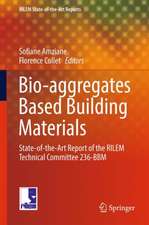International Congress on Polymers in Concrete (ICPIC 2018): Polymers for Resilient and Sustainable Concrete Infrastructure
Editat de Mahmoud M. Reda Tahaen Limba Engleză Paperback – 5 ian 2019
The International Congress of Polymers in Concrete is an international forum that has taken place every three years for the last 40 years with the objective of following progress in the field of polymers and their use in concrete and construction. Following 15 successful congresses held in London (1975), Austin (1978), Koriyama (1981), Darmstadt (1984), Brighton (1987), Shanghai (1990), Moscow (1992), Oostende (1995), Bologna (1998), Honolulu (2001), Berlin (2004), Chuncheon (2007), Funchal (2010), Shanghai (2013) and Singapore (2015), the 16th ICPIC will take place in Washington, DC, from April 29 to May 1st, 2018.
| Toate formatele și edițiile | Preț | Express |
|---|---|---|
| Paperback (1) | 1402.74 lei 6-8 săpt. | |
| Springer International Publishing – 5 ian 2019 | 1402.74 lei 6-8 săpt. | |
| Hardback (1) | 693.20 lei 3-5 săpt. | +60.24 lei 4-10 zile |
| Springer International Publishing – 7 apr 2018 | 693.20 lei 3-5 săpt. | +60.24 lei 4-10 zile |
Preț: 1402.74 lei
Preț vechi: 1710.65 lei
-18% Nou
Puncte Express: 2104
Preț estimativ în valută:
268.42€ • 280.96$ • 223.41£
268.42€ • 280.96$ • 223.41£
Carte tipărită la comandă
Livrare economică 31 martie-14 aprilie
Preluare comenzi: 021 569.72.76
Specificații
ISBN-13: 9783030086336
ISBN-10: 303008633X
Ilustrații: XV, 757 p. 336 illus., 236 illus. in color.
Dimensiuni: 155 x 235 mm
Greutate: 1.07 kg
Ediția:Softcover reprint of the original 1st ed. 2018
Editura: Springer International Publishing
Colecția Springer
Locul publicării:Cham, Switzerland
ISBN-10: 303008633X
Ilustrații: XV, 757 p. 336 illus., 236 illus. in color.
Dimensiuni: 155 x 235 mm
Greutate: 1.07 kg
Ediția:Softcover reprint of the original 1st ed. 2018
Editura: Springer International Publishing
Colecția Springer
Locul publicării:Cham, Switzerland
Cuprins
Part I Keynote Papers.- 1 Concrete-Polymer Materials: How Far Have We Come and Were Do We Need to Go?.- Polymer Concrete for Bridge Preservation.- Feasibility Study of the Use of Polymer-Modified Cement Composites as 3D Concrete Printing Material.- Experimental Analysis and Micromechanics-Based Prediction of the Elastic and Creep Properties of Polymer-Modified Concrete at Early Ages.- Durability and Long-Term Performance of Fiber-Reinforced Polymer as a New Civil Engineering Material.- Nano-modified Polymer Concrete – A New Material for Smart and Resilient Structures.- Part II Polymer Materials.- Bio-Based Superplasticizers for Cement Based Materials.- Screening Encapsulated Polymeric Healing Agents for Carbonation Exposed Self-Healing Concrete, Service Life Extension and Environmental Benefit.- Synthesis and Characterization of Superabsorbent Polymer Hydrogels Used as Internal Curing Agents: Impact of Particle Shape on Mortar Compressive Strength.- Evaluation of Microencapsulated Corrosion Inhibitors in Reinforced Concrete.- The Use of Polymer Additions to Enhance the Performance of Industrial and Residential Decorative Concrete Flooring.- The Effect of Glucose on the Properties of Cement Paste.- Microstructured Polymers and Their Influences on the Mechanical Properties of PCC.- Stability of Latex in Cement Paste: Experimental Study and Theoretical Analysis.- Experimental Verification of Use Secondary Raw Materials as Fillers to Epoxy Polymer Concrete.- Effects of Anionic Asphalt Emulsion on Early Age Cement Hydration.- Polymer Solutions for Protection of Concrete Exposed to Strong Alkaline or Acid Effluent on Industrial Installations.- Lightweight Filled Epoxy Resins for Timber Restoration.- Effect of Methyl Methacrylate Monomer on Properties of Unsaturated Polyester Resin-Based Polymer Concrete.- Analysis of Mechanical Behavior and Durability of Coatingsfor Use as Flooring in the Petroleum Industry.- Evaluation of the Performance of Engineered Cementitious Composites (ECC) Produced from Local Materials.- Application of Phase Change Materials (PCM) in Concrete for Thermal Energy Storage.- Mortars with Phase Change Materials and Stone Waste to Improve Energy Efficiency in Buildings.- Physical and Mechanical Properties of Cement Mortars with Direct Incorporation of Phase Change Material.- Mechanical Performance of Fly Ash Geopolymeric Mortars Containing Phase Change Materials.- Part III Polymer Concrete.- Are Polymers Still Driving Forces in Concrete Technology?.- Mechanical Properties of Polymer Cement - Fiber Reinforced Concrete (PC-FRC) – Comparison Based on Experimental Studies.- Environmental Temperature and Humidity Adaptability of Polymer Modified Cement Mortar.- Innovative Polymer-Modified Pervious Concrete.- Combined Methods to Investigate the Crack-Bridging Ability of Waterproofing Membranes.- Polymer Concrete for A Modular Construction System – Investigation of Mechanical Properties and Bond Behaviour by Means of X-Ray CT.- Bending and Crack Characteristics of Polymer Lattice-Reinforced Mortar.- The Influence of Specimen Shape and Size on The PCC Compressive Strength Values.- Long-term Investigation on the Compressive Strength of Polymer Concrete with Fly Ash.- Overlays: A Great Use for Polymer Concrete.- PC with Superior Ductility using Mixture of Pristine and Functionalized Carbon Nanotubes.- Contribution of Concrete-Polymer Composites and Ancient Mortar Technology to Sustainable Construction.- Smart Monitoring of Movement and Internal Temperature Changes Within Polymer Modified Concrete Repair Patches.- PIC: Does It Have Potential?.- A Perspective on 40 Years of Polymers in Concrete History.- Development Length of Steel Reinforcement in Polymer Concrete for Bridge Deck Closure .- Developmentof Ultra Rapid-Hardening Epoxy Mortar for Railway Sleepers.- Contribution of C-PC to Resilience of Concrete Structures in Seismic Country Japan.- Precast Polymer Concrete Panels for Use on Bridges and Tunnels.- Part IV Polymer Fiber Concrete.- The Effect of Combinations of Treated Polypropylene Fibers on the Energy Absorption of Fiber Reinforced Shotcrete.- Bond Performance of Steel Reinforced Polymer (SRP) Subjected to Environmental Conditioning and Sustained Stress.- High-Strength Strain-Hardening Cement-Based Composites (HS-SHCC) Made with Different High-Performance Polymer Fibers.- Uniaxial Tensile Creep Behavior of Two Types of Polypropylene Fiber Reinforced Concrete.- Dynamic Behavior of Textile Reinforced Polymer Concrete Using Split Hopkinson Pressure Bar.- Steel-Fiber Self-Consolidating Rubberized Concrete Subjected to Impact Loading.- Effect of Fiber Combinations on the Engineering Properties of High Performance Fiber Reinforced Cement Composites.- Application of Fibre Reinforced Polymer Reinforced Concrete for Low Level Radioactive Waste Disposal.- Efficiency of Polymer Fibers in Lightweight Plaster.- Part V Polymer Concrete with Recycled Waste.- Properties of Ceramic Waste Powder Based Geopolymer Concrete.- Use of Recycled Polymers in Asphalt Concrete for Infrastructural Applications.- Influence of Method of Preparation of PC Mortar with Waste Perlite Powder on Its Rheological Properties.- Design and Manufacture of a Sustainable Lightweight Prefabricated Material Based on Gypsum Mortar with Semi-Rigid Polyurethane Foam Waste.- Cement Mortars Lightened with Rigid Polyurethane Foam Waste Applied on Site. Suitability and Durability.- Latex-Modified Concrete Overlays Using Recycled Waste Paint.- Effect of Using Kaolin and Ground Granulated Blast-furnace Slag on Green Concrete Properties.- Lightweight Structural Recycled Mortars Fabricated with Polyurethane and Surfactants.- Hydration in Mortars Manufactured with Ladle Furnace Slag (LFS) and the Latest-Generation of Polymeric Emulsion Admixtures.- Chemical Resistance of Vinyl-ester Concrete with Waste Mineral Dust Remaining After Preparation of Aggregate for Asphalt Mixture.- Part VI Geopolymers.- Performance Studies on Self Compacting Geo Polymer Concrete at Ambient Curing Condition.- Effect of 3D Printing on Mechanical Properties of Fly Ash Based Inorganic Geopolymer.- Optimization of Fly Ash Based Geopolymer Using a Dynamic Approach of the Taguchi Method.- Microstructural and Strength Investigation of Geopolymer Concrete with Natural Pozzolan and Micro Silica.- Performance of Steel-Fiber-Reinforced High Performance One-Part Geopolymer Concrete.- Effect of Different Class C Fly Ashes Composition on the Properties of the Alkali Activated Concrete.- Effect of Curing Temperatures on Zero-Cement Alkali-Activated Mortars.- Properties of PVA Fiber Reinforced Geopolymer Mortar.- Thermal Performance of Fly Ash Geopolymeric Mortars Containing Phase Change Materials.- Development of Fiber-Reinforced Slag-Based Geopolymer Concrete Containing Lightweight Aggregates Produced by Granulation of Petrit-T.- Applications of Geopolymers in Concrete for Low-Level Radioactive Waste Containers.- Part VII Fiber Reinforced Polymers (FRP).- Microstructure and Mechanical Property Behavior of FRP Reinforcement Autopsied from Bridge Structures Subjected to In-situ Exposure.- The Influences of Mechanical Load on FRP Composites Subjected to Environmental Corrosion.- Finite Element Analysis of RC Beams Strengthened in Shear with NSM FRP Rods.- Effect of Sustained Load Level on Long-term Deflections in GFRP and Steel-Reinforced Concrete Beams.- Flexural Behavior and Cracks in Concrete Beams Reinforced with GFRP Bars.- Flexural Rigidity Evaluation of Seismic Performance of Hollow-Core Composite Bridge Columns.- Three-Dimensional Numerical Analysis of Hollow-Core Composite Building Columns.- Pultruded GFRP Reinforcing Bars with Carbon Nanotubes.- On Mechanical Characteristics of HFRP Bars with Various Types of Hybridization.- Fatigue Behavior Characterization of Superelastic Shape Memory Alloy Fiber-reinforced Polymer Composites.- Strength Performance of Concrete Beams Reinforced with BFRP Bars.- Part VIII PC with Nanomaterial.- A Comparative Study on Colloidal Nano Silica Incorporation in Polymer Modified Cement Mortars.- Performance of UHPC and Nano-Modified Polymer Concrete (NMPC) Composite Wall Panels for protective Structures.- Mechanical Characterization of Polymer Nanocomposites Reinforced with Graphene Nanoplatelets.- Oilwell Cement Modified with Bacterial Nanocellulose.- Effect of Incorporating Nano Silica on the Strength of Natural Pozzolan-Based Alkali Activated Concrete.- Part IX Strengthening & Restoration UsingPolymers.- Review of Polymer Coatings Used for Blast Strengthening of Reinforced Concrete and Masonry Structures.- Evaluation of Polymer-Modified Restoration Mortars for Corrosion Resistance of Sewage Treatment Structures.- Finite Element Modeling of CFRP Strengthened Low Strength Concrete Short Columns.- Improvement Works to Existing Column Stumps by Fiber Reinforced Polymer Strengthening System.- Silicone Resin Enclosing Method Applied for the Maintenance of Steel Bearings.- Bio-based Polyurethane Elastomer for Strengthening Application of Concrete Structures under Dynamic Loadings.
Notă biografică
Dr. Mahmoud Reda Taha, PEng, Professor, Chair and Regents’ Lecturer, UNM Civil Engineering. He is a bridge engineer by training and has been a professor at UNM for 15 years where he taught civil engineering materials, fracture mechanics and structural design classes. His research on nanotechnology has been funded by major funding agencies in the US including NSF, DOD and DOE. He has published extensively on mechanical characterization of nano-modified cementitious and polymer composites with more than 300 papers in refereed journals and conference proceedings. He has 3 issued and 7 pending US patents. He is a Fellow of American Concrete Institute (FACI) and currently serves as the Chairman of ACI committee on polymers and adhesives in concrete, associate editor of ASCE Journal of Materials in Civil Engineering and co-chair of ASCE committee on emerging technologies as part of ASCE Infrastructure Resilience Division.
Textul de pe ultima copertă
This volume collects the proceedings from the International Congress of Polymers in Concrete 2018 (ICPIC), held under the theme “Polymers for Resilient and Sustainable Concrete Infrastructure.” ICPIC 2018 provides an opportunity for researchers and specialists working in the fields of polymers to exchange ideas and follow the latest progress in the use of polymers in concrete infrastructure. It also showcases the use of polymers and polymer concrete in sustainable and resilient development, and provides a platform for local and overseas suppliers, developers, manufacturers and contractors using polymers, polymer concrete and polymer composites in concrete structures to develop new business opportunities and follow the latest developments in the field.
The International Congress of Polymers in Concrete is an international forum that has taken place every three years for the last 40 years with the objective of following progress in the field of polymers and their use in concrete and construction. Following 15 successful congresses held in London (1975), Austin (1978), Koriyama (1981), Darmstadt (1984), Brighton (1987), Shanghai (1990), Moscow (1992), Oostende (1995), Bologna (1998), Honolulu (2001), Berlin (2004), Chuncheon (2007), Funchal (2010), Shanghai (2013) and Singapore (2015), the 16th ICPIC will take place in Washington, DC, from April 29 to May 1st, 2018.
The International Congress of Polymers in Concrete is an international forum that has taken place every three years for the last 40 years with the objective of following progress in the field of polymers and their use in concrete and construction. Following 15 successful congresses held in London (1975), Austin (1978), Koriyama (1981), Darmstadt (1984), Brighton (1987), Shanghai (1990), Moscow (1992), Oostende (1995), Bologna (1998), Honolulu (2001), Berlin (2004), Chuncheon (2007), Funchal (2010), Shanghai (2013) and Singapore (2015), the 16th ICPIC will take place in Washington, DC, from April 29 to May 1st, 2018.



























